Plot Twist Story Prompts: Animal Cameo
Every good story needs a nice (or not so nice) turn or two to keep it interesting. This week, the animal kingdom gets involved.
Plot twist story prompts aren't meant for the beginning or the end of stories. Rather, they're for forcing big and small turns in the anticipated trajectory of a story. This is to make it more interesting for the readers and writers alike.
Each week, I'll provide a new prompt to help twist your story. Find last week's prompt, Personal Artifact, here.
Plot Twist Story Prompts: Animal Cameo
For today's prompt, insert an animal into the story. The animal could end up playing a key role in the story, or it could just make a cameo appearance that alters the trajectory of the characters (or reveals something about who they are).
For instance, a walk through the woods can become much more precarious if a bear or pack of wolves appear. Or a snake bites one of the characters. And even the mood can change if two people talking about marriage happen to observe a hawk swoop down and snatch an unsuspecting squirrel mid-conversation.
But animals don't have to be a foreboding force of fury. Rather, they can be a cute distraction or an opportunity to show how a character cares for others around them. While it's not restricted to just animals, this is the thought process behind Blake Snyder's bestselling Save the Cat! books.
Of course, animals can also work as barriers or hurdles in the plot. For instance, a car chase can be stalled by a train blocking the road, but it could also be put on hold by the sudden appearance of a moose or hippopotamus. Maybe a dog starts barking to reveal the presence of someone who is trying to be stealthy (either sneaking up on someone or trying to hide).
Bottom line: Don't forget humans aren't the only living creatures in the world who can impact a story. There are literally trillions of other life-forms ready to twist your stories in new directions.
*****
If you want to learn how to write a story, but aren't quite ready yet to hunker down and write 10,000 words or so a week, this is the course for you. Build Your Novel Scene by Scene will offer you the impetus, the guidance, the support, and the deadline you need to finally stop talking, start writing, and, ultimately, complete that novel you always said you wanted to write.









